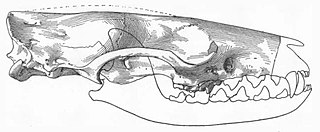
Oxyaena is an extinct genus of placental mammals from extinct subfamily Oxyaeninae within extinct family Oxyaenidae, that lived in Europe, Asia and North America during the early Eocene.

Eomyidae is a family of extinct rodents from North America and Eurasia related to modern day pocket gophers and kangaroo rats. They are known from the Middle Eocene to the Late Miocene in North America and from the Late Eocene to the Pleistocene in Eurasia. Eomyids were generally small, but occasionally large, and tended to be squirrel-like in form and habits. The family includes the earliest known gliding rodent, Eomys quercyi.
Shoshonius is an extinct genus of omomyid primate that lived during the Eocene. Specimens identified as Shoshonius have been found exclusively in central Wyoming and the genus currently includes two species, Shoshonius cooperi, described by Granger in 1910, and Shoshonius bowni, described by Honey in 1990.

Machaeroides ("dagger-like") is an extinct genus of sabre-toothed predatory placental mammals from extinct subfamily Machaeroidinae within extinct family Oxyaenidae, that lived in North America (Wyoming) from the early to middle Eocene.

The Mylagaulidae or mylagaulids are an extinct clade of sciuromorph rodents nested within the family Aplodontiidae. They are known from the Neogene of North America and China. The oldest member is the Late Oligocene Trilaccogaulus montanensis that lived some 29 million years ago (Mya), and the youngest was Ceratogaulus hatcheri—formerly in the invalid genus "Epigaulus" —which was found barely into the Pliocene, some 5 Mya.
Ivanantonia is the only genus in the extinct rodent family Ivanantoniidae and is represented by a single species, Ivanantonia efremovi, from the early Eocene of Mongolia. Ivanantonia is poorly known, with only the lower dentition represented. The genus is unusual among early rodents in lacking all lower premolars and in showing evidence of propalinal chewing. The relationships of Ivanantonia are unclear. It was described as a ctenodactyloid. Hartenberger et al. suggested a potential relationship to the muroid Nonomys but declined to assign Ivanantoniidae to a suborder within Rodentia.
This paleomammalogy list records new fossil mammal taxa that were described during the year 2012, as well as notes other significant paleomammalogy discoveries and events which occurred during that year.
The Willwood Formation is a sedimentary sequence deposited during the late Paleocene to early Eocene, or Clarkforkian, Wasatchian and Bridgerian in the NALMA classification.
This paleomammalogy list records new fossil mammal taxa that were described during the year 2013, as well as notes other significant paleomammalogy discoveries and events which occurred during that year.

The Ash Hollow Formation of the Ogallala Group is a geological formation found in Nebraska and South Dakota. It preserves fossils dating back to the Neogene period. It was named after Ash Hollow, Nebraska and can be seen in Ash Hollow State Historical Park. Ashfall Fossil Beds State Historical Park is within this formation.

The Wasatch Formation (Tw) is an extensive highly fossiliferous geologic formation stretching across several basins in Idaho, Montana, Wyoming, Utah and western Colorado. It preserves fossils dating back to the Early Eocene period. The formation defines the Wasatchian or Lostcabinian, a period of time used within the NALMA classification, but the formation ranges in age from the Clarkforkian to Bridgerian.
The Washakie Formation is a geologic formation in northern Colorado and southern Wyoming. It preserves many mammal, bird, reptile and other fossils dating back to the Lutetian stage of the Eocene within the Paleogene period. The sediments fall in the Bridgerian and Uintan stages of the NALMA classification.

The Bridger Formation is a geologic formation in southwestern Wyoming. It preserves fossils dating back to the Bridgerian and Uintan stages of the Paleogene Period. The formation was named by American geologist Ferdinand Vandeveer Hayden for Fort Bridger, which had itself been named for mountain man Jim Bridger. The Bridger Wilderness covers much of the Bridger Formation's area.

The San Jose Formation is an Early Eocene geologic formation in the San Juan Basin of New Mexico and Colorado.
This paleomammalogy list records new fossil mammal taxa that were described during the year 2009, as well as notes other significant paleomammalogy discoveries and events which occurred during that year.

Prolimnocyon is an extinct paraphyletic genus of limnocyonid hyaenodonts that lived in Asia and North America during the late Paleocene to middle Eocene. Prolimnocyon chowi is the earliest known member of the hyaenodontid family Limnocyonidae.

Viverravus is an extinct genus of placental mammals from extinct subfamily Viverravinae within extinct family Viverravidae, that lived in North America, Europe and Asia from the middle Paleocene to middle Eocene.

Nyctitheriidae is a family of extinct eulipotyphlan insectivores known from the Paleocene and Eocene epochs of North America and Asia and persisting into the Oligocene of Europe. Several genera, including Nyctitherium, Paradoxonycteris, and Wyonycteris, have initially been described as bats, although the family is more frequently placed in the order Eulipotyphla.

Oxyaeninae is an extinct subfamily of placental mammals from extinct family Oxyaenidae, that lived in Asia, North America and Europe from the late Paleocene to middle Eocene.

Metacheiromyidae is an extinct paraphyletic family of myrmecophagous placental mammals within extinct order Palaeanodonta, that lived in North America and Europe from the late Paleocene to middle Eocene.












